Microsoft doesn't seem to be intimidated by anything. That same brash confidence that began with Microsoft's entry into the console gaming market continues with Forza Motorsport, the company's take on the driving simulator, a genre that has been the sole console purview of Sony for nearly a decade. And what a debut it is. Forza Motorsport is a stylish and challenging game that is easily one of the best racers on the Xbox, if not the best.
A preliminary look at Forza's content will give you a good idea of the scope of the game. There are more than 230 cars from 60 manufacturers and a track list that, if not extensive, at least features a nice mix of tight street courses, real race tracks from all over the world, and challenging fictional environments. True, when it comes to cars and tracks, Forza is not the biggest racing simulator out there. The variety of things you can do with the content that is present, however, truly makes all the difference.
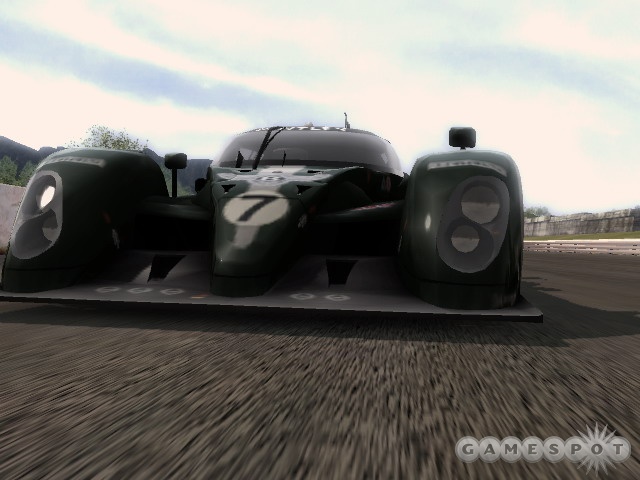
From a driving standpoint, Forza has a sophisticated feel to it, and one that accommodates a variety of skill levels. With all the default assists enabled, such as traction control, antilock braking, and stability management, you'll be tearing around hairpin corners in Tokyo and ripping up the Laguna Seca corkscrew nearly right out of the gate. Cars feel nicely heavy under acceleration and (perhaps more importantly) braking, meaning that setting up proper brake points and turns is essential. If you don't have the slightest clue about entry points into turns or when to step on the brakes, Forza has a handy "suggested line" feature that is one of the slickest innovations in racing games to come along in a long time.
When activated, the suggested line acts as a dynamic tutor that demonstrates the line over which to drive, as well as how much gas or brake pressure to apply at any corner on a track. Because the suggested line is dynamic, it changes depending on the car you're in and the speed at which you are traveling. As you approach a turn, the line will change from green (which means accelerate), to yellow (lift off the gas), and finally to red (hit the brakes). As you make your way through the corner, the line will transform in reverse, from red, to yellow, and eventually back to green, letting you know it's time to slam the hammer down. This is an ingenious and effective tutor for those new to driving games as well as for experienced players. It allows the novice to be quick right away and helps experienced drivers either learn a new course with which they are not familiar, or drop those extra tenths from their lap time. Is the system perfect? No. As you become more familiar with the suggested line, and the course on which you're driving, you'll notice there are times when you can ignore the advice to slow down, especially on quick S-turns. Furthermore, some braking distances suggested by the line tend to be a bit on the optimistic side. The biggest downside to the suggested line is becoming overly reliant on it. After running lap after lap with the suggested line feature enabled, you may feel a bit vulnerable, and your lap times will inevitably suffer when you first turn it off. Still, as an inventive and effective tutoring tool, it's a great feature.
Becoming reliant on the other aids in the game, such as ABS or traction control, is forgivable, because many of the cars found in Forza contain these types of assists in real life, and as you might expect, there is a huge leap in skill required with these assists turned off. Disengaging stability management, for example, might make it easier to pull off extremely cool powerslides. But, unless you're willing to chalk up some serious practice miles, only the most experienced drivers will find success in driving without at least a few of these assists enabled.
Forza's driving controls are flexible and sensitive, and you always have a wealth of data at your fingertips, like information on car damage, engine and tire temperature, and the many camera viewpoints. There are two first-person perspectives to choose from, including one worm's-eye view that dramatically enhances the sense of speed and two third-person cameras. When driving in first-person view, a handy rearview mirror makes spotting your stalking opponents easy. You'll also be able to use the right analog stick to look directly left, right, or behind, or at 45-degree angles both behind and in front of the car. Analog gas and brakes feel nice, and although the game won't let you map buttons in the exact configuration that you'd like, there are several options to choose from that cover the majority of racing fans' preferences for gear shifting, steering, gas, and brakes.
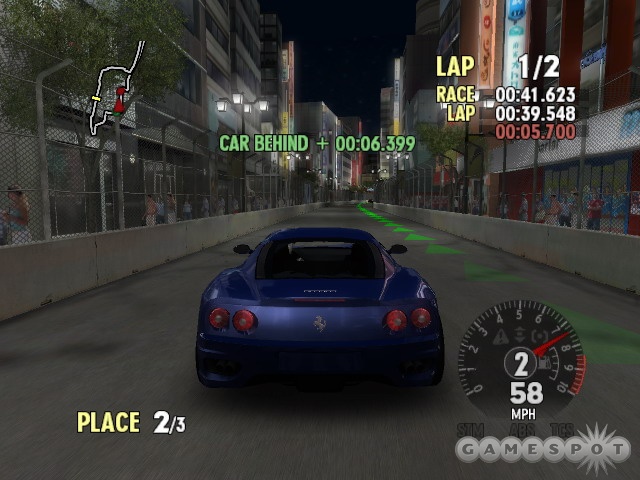
You'll need to get very comfortable with the controls to take on the crafty and subtle opposition found in Forza, which stands as one of the game's pinnacle achievements. On an oval, for example, cars will seek drafting help wherever they can get it in order to move up the pack. Artificial intelligence-controlled cars will block passing attempts and try to swerve around you if they're approaching too quickly. Yes, that's right folks, Forza features driving foes that are aware of your position on the track and will react accordingly, which works both for you and against you, depending on your driving style. If you drive a clean race and avoid rubbing bumpers with your ontrack foes, they'll mostly drive cleanly as well. If you want to play some bumper cars with them, the AI will be more than happy to oblige and will likely spear you at the next 90-degree turn in retaliation. Of course there's room for improvement. The AI tends to be overly hesitant on certain S-turns, and a tightly bunched group of computer-controlled cars can sometimes result in a chain-reaction pileup that you can only hope to be in front of. In short, while the AI is not above making aggressive, even stupid, moves to pick up race positions, for the most part it drives remarkably clean, skillful, and consistent laps.
The deft nature of the Forza AI design doesn't just pertain to the opponent cars. The drivatar system is designed to emulate your particular approach to the different types of corners found in the game. You start off by training your drivatar on a number of tracks and in cars of various drivetrains. As you make your way around the courses, you'll be graded on how successfully you navigate the types of turns that compose the track. Once you've completed all the training tracks, and the system has a relatively complete picture of your style, you can enter your drivatar into races in your stead, though it will cost you credits to do so. You can even set up races against a number of drivatar copies of yourself, observe your drivatar on any track in any car in your garage, or even trade drivatar profiles with your friends by saving them to a memory card. And you can always go back to the training mode to try to improve your cornering skills, thus improving your drivatar skills while you're at it.

While interesting, the drivatar system isn't perfect. For one, it doesn't take into consideration familiarity with a specific track layout. Even if you have a low performance score on a hairpin corner at Blue Mountains Raceway, for instance, it doesn't mean you can't skillfully attack the Andretti Hairpin at Laguna Seca through the benefit of rote memorization. For another, your drivatar is seemingly consistent to a fault. Six laps at Laguna Seca will almost always result in six offtrack incidents at the corkscrew if your skill ratings aren't high enough (even if you can manage to get through that difficult section of track with little trouble when actually driving the car).
Like almost any driving simulator, a big portion of the fun in Forza is found in buying and collecting cars. Forza puts a twist on this by introducing the concepts of regions and rarity into the mix. Upon creating a profile in the game, you'll be asked to choose a home region from North America, Asia, or Europe. Your choice of region will affect the availability and cost of cars and parts from manufacturers both in and out of your chosen region. For instance, by choosing North America as your home region, you'll find that rare high-performance North American cars will be more affordable than unusual Asian or European models. In addition, the types of manufacturer relationships you form as you gain levels in the career mode will change depending on the region you choose in the beginning of the game.
The rarity of your car affects its resale value online (more on that in a bit), as well as its earning power in a career mode race. After all, one of the ways you build up a world-class collection of automobiles in Forza is by buying them with credits earned from races in career mode. The number of credits you earn per race is determined by more than just what place you come in when the checkered flag waves. You'll also earn bonus credits for driving with fewer assists, driving with the suggested line feature disabled, or by bumping up the ability of the crafty AI competition. In effect, the more you handicap yourself in a race, the more chance you have for earning huge credits when the race ends. The system also takes into consideration how cleanly you drove, as you'll be paying for any damage incurred to your car directly out of the winnings you earn.
By installing upgraded parts in your ride, you'll increase the performance of your car, as well as its level. Strangely, customizing your car's exterior with a new paint job or unique decal configuration does not affect its rarity level, even though these two tools are the very thing that will likely make your RX-7 different from everyone else's in the Forza universe. If you wish to rarify your car, you'll need to shell out the cash to do so. Upgrades can also change the class your car belongs to, which can mean that it will no longer be available for certain class-restricted races, an interesting, if not 100 percent effective solution to the "max out your car and blow the doors off your competition" approach found in other driving games.
Credits count for more than just bankrolls in Forza; they also determine your progress level in the game. The latter races, such as the championship and endurance series, as well as a number of amateur and pro series races, are unlocked only once you've reached a certain level. In a nice touch, the money you spend on new rides and new parts does not count against your level; cumulative credits over the course of your career are all that's important here.
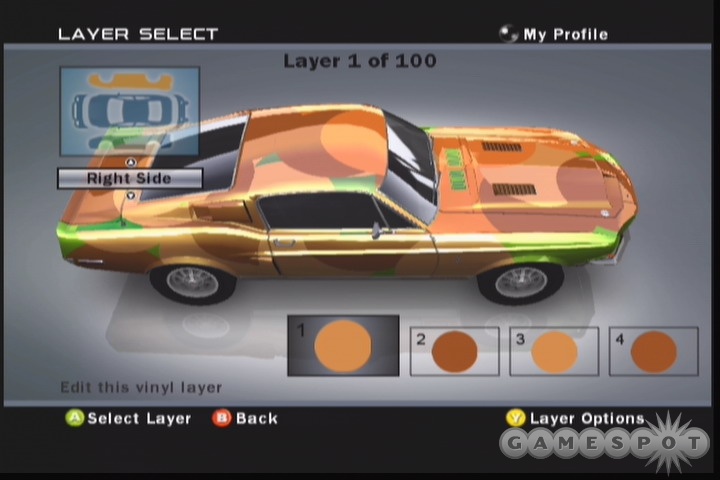
What can cost you is incurring too much damage on your car in a career mode race. Forza features one of the most finely tuned and exciting damage models ever seen in a console racing simulator. There are two levels of damage to choose from: cosmetic and simulation. In addition to the aforementioned monetary hit you'll receive for banging around the track, collecting too many dings on your ride can also severely affect the performance of your car, especially with the simulation damage option enabled. You can feel the scope of the damage model in a variety of ways, ranging from simple acceleration and top-speed degradation or steering trouble to more subtle performance issues, such as increased gear shift times. In simulation damage mode you'll even need to keep a watchful eye on your gear shifting, especially at the start of a race, as prolonged high revs will do damage to your engine. Parts fly off during violent wrecks, only to become obstacles during the next lap and, if you can't totally kill a car by repeatedly ramming it into a wall, at the very least you can do enough damage to reduce it to a limping shambles.
Running a clean race has rewards of its own, and not all of them are monetary in nature. Because of Forza's close integration with Microsoft's Xbox Live service, all your race times are automatically uploaded to compare with those of other racers from around the globe. However, the game will levy a stiff time penalty against you for ontrack mistakes, whether they're collisions with other cars or other roadside obstacles, or simply going wide in a turn and skidding offtrack. The penalty system unfortunately doesn't take into consideration the actions of the usually polite AI, so even if you're rammed from behind or driven offtrack by an overzealous opponent, it's your lap time that will suffer.
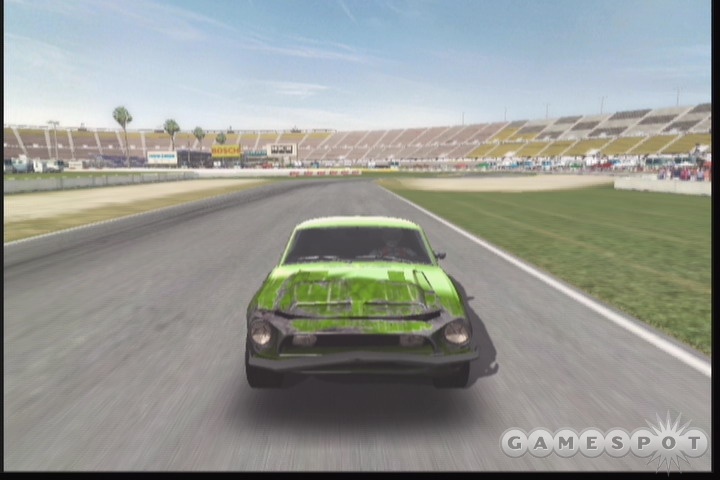
Luckily, this is practically the only ugly spot in an online package that is seamless and wonderfully implemented. In addition to being able to host and join both circuit and point-to-point race types on any of the included tracks with up to seven other online racers, the game also includes an online career mode that lets you race against opponents of your skill level based on an in-game ELO rating similar to that used in international chess competitions. We experienced smooth online play in our Forza online test sessions, seeing no slowdown and only a few cases of cars lag-sliding across the track. The number of options for online races is impressive--from setting the number of laps or damage type to determining whether tire wear, fuel consumption, or collision are enabled. The only thing missing is a setting to forbid use of the suggested line aid in online races. We would have liked to have seen the option to disable this feature, or perhaps disable it after the first lap of a race, if only to avoid people using it as a crutch for online races. Furthermore, a maximum of eight racers online seems a bit low, especially since older racers have managed to pack in more online opponents without negative performance effects. Finding a group of like-minded race fans online--people you know can be counted on for a solid race session after session--can be difficult. Forza attempts to address this by taking the concept of your friends list one step further with car clubs, which are the game's version of a clan. Establishing a car club is easy: you choose a name, nickname, a brief description, motto, Web site information, a logo...and you're all set. As president of your car club, you'll be able to recruit and promote new members in the hopes of building up a powerful group of drivers. If you have at least four members in your club, you'll be able to post times to the Xbox Live car club scoreboards. Your car club will have an overall ELO rating attached to it as well, and all members of the club will contribute to that rating (in ELO rating-enabled races that is), meaning every single member has a stake in the overall reputation of the club.
Forza places a huge emphasis on every car's individuality through features such as the rarity rating and powerful customization tools, which let you paint your car and/or add a massive number of vinyls and decals, creating, with a little patience, a car that will be unique and unlike any others. That individuality can be further celebrated by pitting your car against other players' cars online. The fun doesn't stop there, however, as Forza also lets you buy and sell cars in online trading sessions with friends and strangers alike. By setting up a "buy and sell" session, you can browse the collections of up to eight other players who agree to enter the lobby with you. You can't set the price at which you'd like to sell a particular car unfortunately; the price is automatically generated based on the rarity of the vehicle and the quality of upgrades it contains.
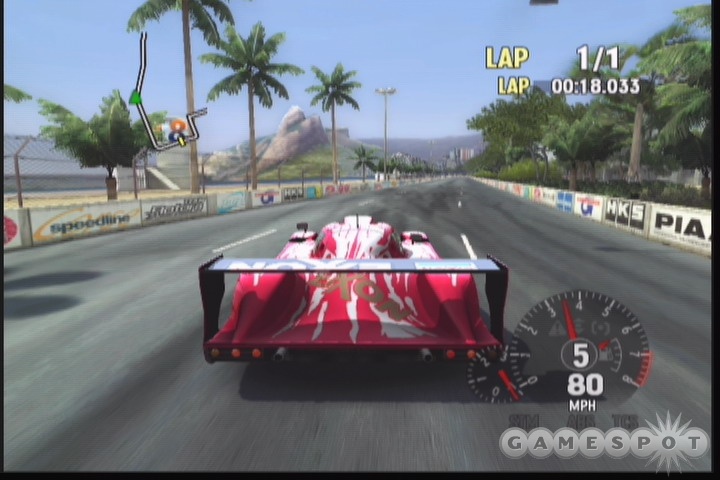
The graphical beauty found in Forza starts with the big, bright car models. The smooth lines on the car models are of exceptional quality and appear remarkably similar to their real-life counterparts, all the way down to the ridges on the tires and the detailed grills. As nice as the cars look, the real feather in Forza's cap may come in the game's racing environments. Real-time lighting and shadows are shown off to great effect on tree-lined courses like Maple Valley and Blue Mountains Raceway, as well as the cityscape of the New York City track--an intricate mix of urban grit and metropolis glitter--and it all results in a stunning graphical achievement. There are oodles of graphical treats on other courses as well, like the unique tunnel lighting at Rio de Janeiro, the neon-soaked Tokyo course, and the absolutely massive amounts of background detail on Germany's Nürburgring. The 'ring seems to be a regular guest star in today's racing games, but never has it looked as lush, as opulent, or simply as immense as it does in Forza.
There are four camera angles to choose from--two that are above the car and two that are from a first-person view. True cockpit views would have been welcome here, as they are in any racing sim, but all four cameras present a nice sense of speed, and the addition of a rearview mirror in the two first-person cameras is a nice touch. By using the right thumbstick on the Xbox controller, you can look behind you, to the left or right, or you can swing the camera at angles both in front of and behind your car. These additional views are a handy tool to have at your disposal when setting up turns or braking points, especially when there is an opponent's car in your blind spot. Pressing the white button brings up two car-status screens in succession, the first of which illustrates damage to your car's exterior and interior using a color-coded system. The second screen shows engine and tire temperature, which are only especially relevant during longer races.

Perhaps the best aspect of Forza's presentation is in the game menus, which do a fine job of sorting through a massive amount of information. Many of the race types, for instance, feature strict restrictions on things like car class, make, or horsepower. When navigating these race series screens, the menus let you know exactly how many cars you own that meet the current restrictions, and if you enter a race (even if you're currently in a car that doesn't meet the limitations), you'll be immediately taken to your garage, where only the eligible cars you own will be displayed. That same level of detail can be found in the car-purchasing screens. In addition to being able to choose cars by country of origin or drive type (among many other criteria), you can also sort by price and look at only the cars that you can currently afford. Tuning your car is easy, and basic explanations of what each attribute does and how it affects the car are welcome additions for those who can't tell a driveshaft from a spark plug. You can even check out a handy benchmarking page that will give you a quick summary of your car's performance in areas such as 0 to 60mph and 0 to 100mph times, braking distances, and lateral Gs.

The sound in Forza comes in two flavors: finely tuned and lightly cheesy. First, the good news: The symphony of automotive horsepower in Forza is sweet on the ears. Distinctive engine sounds are bolstered by position-specific presentation. The timbre of your car's engine will be distinctly different when driving in a first-person viewpoint compared to driving with the camera high above your car, or even when you're peeking out the rear of your car using the right thumbstick. As your opponents are bearing down on you, you'll not only see them in your rearview mirror, but also hear the distinct roar of their engine as they approach. It makes for a great mechanical soundtrack, and one that's best enjoyed with your television or stereo speakers turned way up. Unfortunately, the same can't be said for the musical soundtrack, which is exemplified by lackluster guitar rock and uninspiring pseudo cover tunes, like ZZ Top's "La Grange" and Black Sabbath's "Iron Man." Luckily, the game supports custom soundtracks, so this auditory problem should only last as long as it takes you to get your CD collection ripped to your Xbox hard drive.
Forza's main success is in finding a blend between pleasing the notoriously fickle minority that likes its driving games consistently challenging and demandingly detailed, while introducing a set of user-friendly assists that will ensure that even those who are new to the racing genre will enjoy themselves. Forza may well be remembered as a title that, through its mix of challenge and control, introduced an entirely new set of fans to the beauty and power of driving games.